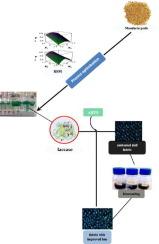Repurposing mandarin peels for catalytically robust laccase production using Achromobacter denitrificans ISO16
IF 4.2
Q2 CHEMISTRY, MULTIDISCIPLINARY
引用次数: 0
Abstract
Mandarin peels are an abundant and underutilized waste resource rich in polysaccharides, polyphenols and other essential nutrients. It is presumed that this resource can be harnessed for microbial fermentation processes, particularly catalytically-robust laccases production. This study investigated the bio-valorization of mandarin peels through response surface methodology (RSM). The model generated facilitated the computation of interactive experimental factors (pH: 5, mandarin peels: 12.5 g/L agitation: 100 rpm, NH4NO3: 1 g/L) that stimulate maximum yield of laccase (136 U/mL) secreted by Achromobacter denitrificans ISO16. Consequently, ISO16 laccase demonstrated tolerance, recouping at least 77 % activity after exposure to extremes in pH, temperature, salts, cations, anions and surfactants. Moreover, it was able to decolourize up to 0.2 % w v−1 (2 g/L) concentrations of synthetic dyes and correspondingly facilitate a single-loop denim biobleaching. These characteristics pose ISO16 laccase as a potential industrial biocatalyst and emphasizes the importance of optimized valorization of mandarin peels to solve environmental pollution.

利用反硝化无色杆菌ISO16对柑桔皮进行催化强力漆酶生产的再利用
柑桔皮是一种丰富而未被充分利用的废弃资源,富含多糖、多酚等必需营养素。据推测,这种资源可以用于微生物发酵过程,特别是催化活性强的漆酶生产。本研究采用响应面法(RSM)对柑桔皮的生物增殖进行了研究。所建立的模型有助于计算促进反硝化无色杆菌ISO16分泌漆酶最大产量(136 U/mL)的交互实验因子(pH: 5,橘子皮:12.5 g/L搅拌:100 rpm, NH4NO3: 1 g/L)。因此,ISO16漆酶表现出耐受性,在暴露于极端的pH值、温度、盐、阳离子、阴离子和表面活性剂后,至少恢复了77%的活性。此外,它能够脱色高达0.2% w v - 1 (2 g/L)浓度的合成染料,并相应地促进单环牛仔布生物漂白。这些特性使ISO16漆酶成为一种潜在的工业生物催化剂,并强调了柑橘皮优化活化对解决环境污染的重要性。
本文章由计算机程序翻译,如有差异,请以英文原文为准。
求助全文
约1分钟内获得全文
求助全文

 求助内容:
求助内容: 应助结果提醒方式:
应助结果提醒方式:


